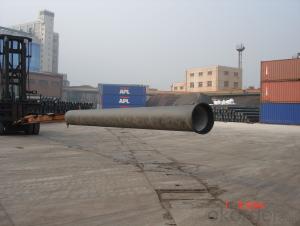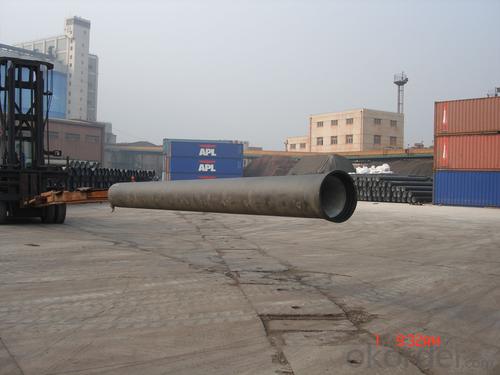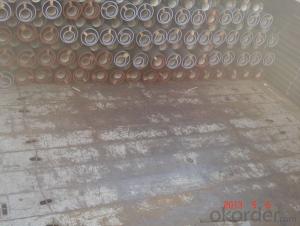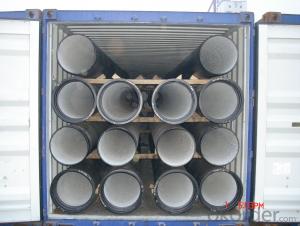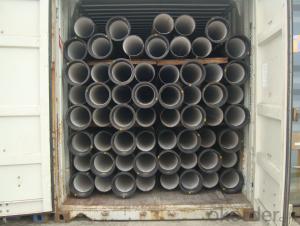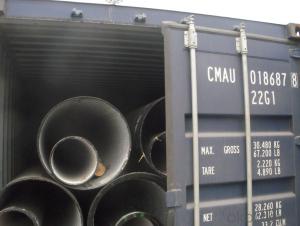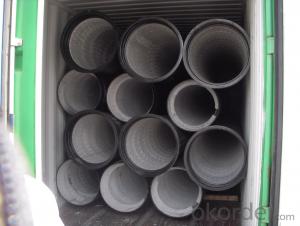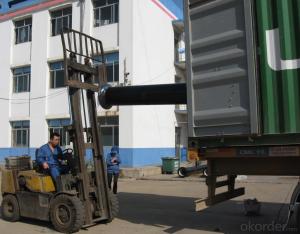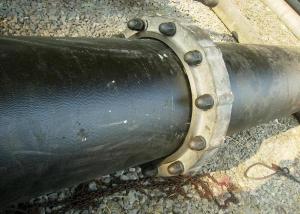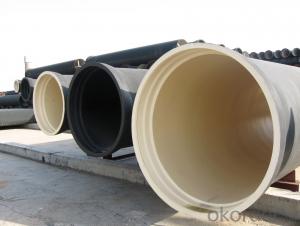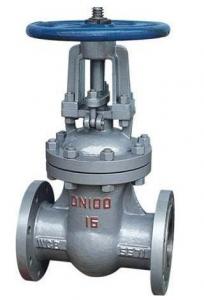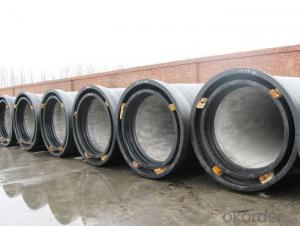DUCTILE IRON PIPE AND PIPE FITTINGS C CLASS DN800
- Loading Port:
- Tianjin
- Payment Terms:
- TT OR LC
- Min Order Qty:
- 23 pc
- Supply Capability:
- 3000 pc/month
OKorder Service Pledge
OKorder Financial Service
You Might Also Like
· Material : Ductile Cast Iron
· Size Range : DN 80mm to DN 2000mm
· Unit Effective Length : 6m or 5.7m
· Manufacture Standard: ISO 2531:1998/ EN 545:2006/EN 598:2007
· Annual capacity : 200,000 tons
· Coating Exterior: Zinc 130g/m2 according to ISO 8179-1 and bitumen coating 70 microns.
· Cement Interior: Portland Cement/ High Alumina Cement/ Sulphate Resisting Cement Lining according to ISO 4179
· Special requirements on external coating and internal lining can be applied
· We also provide accessories such as SBR/EPDM rubber gaskets, lubricant paste, pipe caps, PE sleeves, etc.
Additional Parts:
Each pipe is strictly inspected according to related standard to ensure permanently high performance.
Easy Installation at site and service free for life
Long Service Lifespan
Quotation will arrive you within 24hours once we get your inquiry.
We guarantee offering you a competitive price.
A copy of original inspection reports of pipes will be offered after shipment.
Photos of loading process will be sent to the customer after shipment effect.
We will follow-up the delivery progress after shipment effect and update to the customer on weekly basis.
- Q: What are the common pressure ratings for ductile iron pipes?
- The common pressure ratings for ductile iron pipes typically range from 150 psi (pounds per square inch) to 350 psi.
- Q: Principles for the antiseptic treatment of ductile iron pipes
- The principle that the antiseptic treatment of ductile iron pipes must be complied with is that.1. internal and external surface coating shall be kept clean, remove rust and impurities2. after coating on the inside and outside surface, the coating should be even and smooth, firm and firm, and shall not be abnormal because of climate change3. coating for water delivery should be insoluble in water, no peculiar smell, harmful impurities content
- Q: What are the typical joint restraint requirements for ductile iron pipes under pressure?
- The typical joint restraint requirements for ductile iron pipes under pressure involve the use of mechanical joint restraints or restrained joint systems. These restraints are necessary to prevent the pipes from separating or pulling apart due to the internal pressure exerted on them. One common type of joint restraint is the mechanical joint restraint, which consists of a series of bolts and clamps that securely hold the pipes together. These restraints are typically applied at each joint of the ductile iron pipes to ensure a tight and secure connection. Mechanical joint restraints provide axial restraint, preventing the pipes from separating in the direction of the pipe axis. Another type of joint restraint used for ductile iron pipes is the restrained joint system. This system involves the use of a specially designed joint that provides both axial and angular restraint. The restrained joint system typically consists of a gasket, a restraining gland, and a series of bolts or wedges. The gasket provides a watertight seal, while the restraining gland and bolts/wedges restrain the pipe joints, preventing separation under pressure. The specific joint restraint requirements for ductile iron pipes under pressure may vary depending on the diameter, wall thickness, and operating conditions of the pipes. It is important to consult the manufacturer's guidelines and industry standards to determine the appropriate joint restraint system for a given application. Additionally, proper installation and maintenance of the joint restraints are crucial to ensure their effectiveness and longevity in restraining the pipes.
- Q: What are the common methods for flow control in ductile iron pipes?
- The common methods for flow control in ductile iron pipes include the use of valves, such as gate valves, butterfly valves, and check valves. These valves are designed to regulate the flow of water or other fluids in the pipe, allowing for control and adjustment of the flow rate. Additionally, flow control can also be achieved through the use of flow meters and flow regulators, which monitor and regulate the flow of fluids through the pipe system.
- Q: Are ductile iron pipes resistant to abrasion or wear?
- Yes, ductile iron pipes are highly resistant to abrasion or wear. Ductile iron, also known as cast iron, is a strong and durable material that is specifically designed to withstand abrasive conditions. The unique microstructure of ductile iron provides excellent resistance to abrasion, making it an ideal choice for applications where pipelines are exposed to high levels of wear. Additionally, ductile iron pipes are known for their long service life, which further demonstrates their ability to withstand abrasion and wear over time.
- Q: How many meters does the cast iron water supply pipe dn150,1 tons?
- When pouring added calcium alloy in the flow inlet for graft inoculation, every time after the pouring, need in the mold surface with compressed air spraying a thin layer of dry calcium silicate powder, a centrifuge is composed of upper and lower halves of the closed shell, the supporting cast roller is installed on the bottom of the shell, the mold in front of a ring gear mounted on the housing at the end of the DC motor through the transmission gear direct mold, shell mold through Hugh ends are equipped with sealing ring, the front end of the shell shell installed with half ring a turning cylinder pictophonetic mountain Rae centrifuge under the wheels, so as to make reciprocating motion on the inclined orbit
- Q: How to distinguish flexible and rigid interfaces between cast iron pipe joints
- Flexible connections can be kept watertight at any angle (lateral or vertical), and rigid, where the interface of a pipe is easy to crack if a slight earthquake is encountered
- Q: How is ductile iron pipe protected against external corrosion?
- Ductile iron pipe is protected against external corrosion through a variety of methods that ensure its durability and longevity. One common method is the application of protective coatings. The pipe is typically coated with a layer of zinc or asphaltic material, which acts as a barrier between the iron pipe and the surrounding environment. This coating helps to prevent direct contact between the pipe and corrosive elements such as soil, moisture, and chemicals, thereby reducing the risk of corrosion. Additionally, ductile iron pipes are often wrapped with a layer of polyethylene or polypropylene tape. This tape provides an extra layer of protection against external corrosion by serving as a physical barrier that shields the pipe from moisture and other potentially corrosive substances. The tape is applied with care to ensure complete coverage and adherence to the pipe's surface. Furthermore, cathodic protection is commonly employed to safeguard ductile iron pipes against external corrosion. This technique involves the installation of sacrificial anodes or impressed current systems near the pipe. These anodes generate a protective electrical current that counteracts the corrosion process, effectively inhibiting the deterioration of the pipe's surface. Lastly, proper installation practices play a crucial role in preventing external corrosion. It is essential to ensure that the pipe is buried at an appropriate depth, allowing for adequate soil coverage. This helps to minimize exposure to corrosive elements and maintain the integrity of the protective coatings. Additionally, proper backfilling techniques and the use of corrosion-resistant bedding materials can further enhance the pipe's resistance to external corrosion. In conclusion, ductile iron pipe is protected against external corrosion through a combination of protective coatings, tape wrapping, cathodic protection systems, and proper installation practices. These measures work together to provide a robust defense against the corrosive forces that the pipe may encounter, ensuring its longevity and reliability in various applications.
- Q: How can stainless steel pipes and ductile iron pipes be joined?
- Or with a gland type expansion joint, by tightening the pressure plate bolts, sealing pipe fittings and pipe wall, so as to achieve sealing, while retractable function
- Q: How much pressure can the ductile iron pipe socket meet?
- If you let him as the supporting points, I do not recommend this
Send your message to us
DUCTILE IRON PIPE AND PIPE FITTINGS C CLASS DN800
- Loading Port:
- Tianjin
- Payment Terms:
- TT OR LC
- Min Order Qty:
- 23 pc
- Supply Capability:
- 3000 pc/month
OKorder Service Pledge
OKorder Financial Service
Similar products
Hot products
Hot Searches
Related keywords
